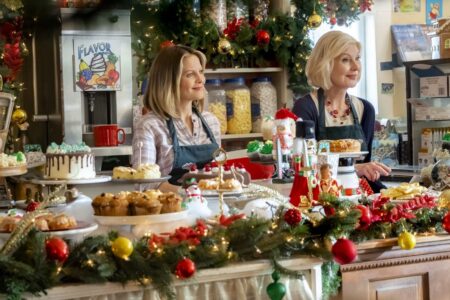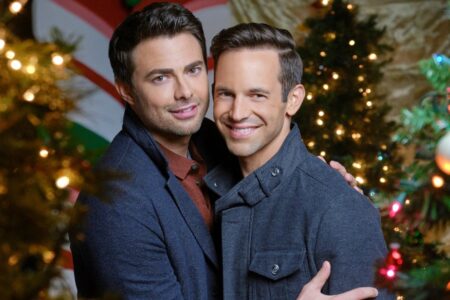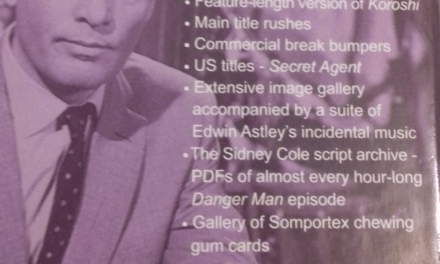Ext. Day
Long shot of snow covered small town. As the camera gets closer to the town lights on trees become visible. It begins to snow.
Dissolve to Interior day. Mid shot of a woman sat at a computer typing. By the side of the key board is a cup steaming slightly with hot chocolate, whipped cream, mini marshmallows and a candy cane.
The reverse angle shot reveals a living room with a Christmas tree fully decorated, red bows, strings of Christmas lights. Cards are hung from a red sash above a stone fireplace. In fact the entire frame is filled with a variety of Christmas decorations. (plus poinsettias!)
Cut to computer screen. We see a set of financial figures. The woman sighs and says out loud to herself, ’Is this the end of the family business?’
Cut to interior day café. Another hot beverage and the woman and friend are chatting as a young man in a full length coat enters from the now falling snow. The friends exchange glances.
If you have ever watched a Christmas TV film from the Hallmark stable, and imitators, you’ll know the rest. In the next 90 minutes, or so, the family business will be saved, the Christmas play/festival/competition will also be saved and the woman and the man entering the café will be romantically entangled, probably after picking out a Christmas tree together. There may also be a different, Christmas wedding happening in the town. It will be a home town returned to by at least one character and then never left. If you have not seen them in the U.K. Channel 5 starts screening these in early October and they continue until nearly Christmas with 2 or 3 playing a day on weekdays and perhaps only 2 on Saturdays. From this you can ascertain there is a sizeable body of production in this genre.
Trailer for one of the ‘classic model’ films, Christmas Town (2019)
This is ‘Invisible TV’ writ large, television that though watched by many is not critically discussed. In the context of Channel 5 it does attract high ratings, around 1 Million for the more popular offerings.
However , their status in TV production and consumption is probably close to zero. This could be for all sorts of reasons, but let me suggest 4 leading contenders:
- Broadcast slot – daytime TV
- Perceived audience
- Genre limitations
- Budget and related to that mise en scene
So why consider these TV films? I think they open up the continuing debate on television drama and quality. The terms quality has been used in a number of different ways in television studies and beyond. So much of writing on television starts from either a desire to gain status for a programme or genre or an assumption of that status. I was reminded of the influence of spectator position and value by Janet Mc Cabe on a recent online event about The Bridge and transnational TV hosted by the University of Aberystwyth . But, isn’t that time for worrying about the status of television texts over? Allowing us not to as first ask, ’Is this o.k., do others rate it’, but simply to look at the very broad spectrum of production. I’m aware that this is not entirely a new idea. Quite a few people have been considering daytime TV for some while. Indeed for several years in the 2010’s I used to teach with Doctors (BBC)and ask students, much to their annoyance, to watch an episode and then try to quantify exactly why it was not ‘quality’, ‘serious’ or just good TV drama. Importantly, could they actually identify the key differences from more prestigious TV dramas that they did like. It was also interesting that much of the reluctance to watching Doctors was voiced in terms of their perceived knowledge of the audience – what my granny, auntie or mum watches.
Back in Hallmark Christmas territory, the genre is fixed, but a wider viewing suggests that there are variants and indeed a sort of corporate/at work sub genre. Personally I find these much less interesting since they tend to compete head to head with mainstream Christmas cinema. I must confess to only having watched about 40 films so far, so more material is to emerge here. It is the ‘classic’ model that works best for me. – the completely over the top alternative reality Christmas in a small town film. Incidentally, it is these films in the genre that place set designers, costume and props people together with stylists centre stage. A rarity, I would suggest in all but the costume drama. This leads to criticism that they are all look and no substance. Since there is little room to move in acting, narrative and cinematography, it is here that flair does, or does not, show, I would suggest.
Social and distracted viewing
One of the pleasures of watching these films for me in Covid times was to be on Whatsapp with my two daughters whilst watching. Details of mise en scene and the narrative form a constant discussion and whilst this can be on a ‘so bad it’s good’ basis, it more often is to exchange admiring comments on the set and costume. The dialogue is the basis of most of the that’s dreadful type exchanges. (‘I’ve heard you like to whittle’ remains one of my favourites.) Such are the rigid elements of the genre that you can play a kind of genre spotting bingo whilst you watch. I imagine this could be adapted to a drinking game, but with dire consequences – the tropes and iconography come thick and fast in the first quarter of an hour!
It’s also possible to watch these films whilst being distracted occasionally since the narrative trajectory is usually easy to predict. That together with a countdown days to Christmas or Christmas event, display board soon tells you where you are in the narrative. This could allow for viewing fitted around other tasks such as caring or household tasks. This is pure supposition, but it would seem to make sense that audiences need not be fully engaged at all times.
Ideology
At first the ideology of these films seems clear. The narratives are traditionally based and indeed most seem to derive from either A Christmas Carol or It’s a Wonderful Life with perhaps shades of Miracle on 34th street. Our heroine seeks fulfilment through entrepreneurial capitalism and heterosexual love. Indeed so chaste are these films that once the couple kiss, that’s it, roll credits. However, there are additional and contradictory values embedded in the narrative. Self-realisation or actualisation is also a goal here. In the small town it is possible to rediscover yourself. This seems to trump any need for financial success.
Although previously resolutely heterosexual, things are changing. Two recent films feature gay relationships. In the very recent, The Christmas House (2020), the central couple are 2 men and it is the story of our hero’s quest for love that we follow. There is also The Christmas Set Up (2020) It should be noted that both films are produced for the Lifetime Channel, rather than Hallmark.
Trailer for The Christmas House( 2020, Lifetime)
Trailer for The Christmas Setup (2020)
https://imdb.com/video/vi1178124569?playlistId=tt13147656&ref_=tt_ov_vi
Hallmark, itself is a conservative company, pulled a wedding planners advert with a same sex couple after viewer pressure.
In the U.K. this is somewhat undercut by the sponsorship message from match.com often featuring a lesbian couple. There seems to have been no reaction to this from Channel 5 audiences. All of this does make one wonder if the films also represent a Republican’s, possibly not Trump supporter(?), approach to Christmas.
In terms of diversity, what is most noticeable is the number of major parts for black actors. There are a few films where all the major roles are non-white characters. Furthermore, it could be argued that all of these representations are positive, though that assertion might need some further analysis and discussion. It’s very hard to put a meaningful figure on this, but it seems to this viewer that the proportion of black characters is higher than mainstream, North American TV or Film. Black/White relationships are also pretty much the norm here rather than the exception. And yet, like the sit.com. one could argue that the genre is so constrained that this is not of wider significance?
The Small Town
‘No I cannot forget where it is that I come from
I cannot forget the people who love me
Yeah, I can be myself here in this small town
And people let me be just what I want to be.’
Small Town, John Cougar Mellencamp 1985.
Ever since Mark Twain’s Tom Sawyer and Laura Ingalls Wilder’s books, the U.S. small town has been mythologised in American popular culture. Thornton Wilder’s play Our Town testifies to the durability and special nature of the small town. Conversely, Truman Capote’s In Cold Blood throws a much darker light on smaller communities. In the myth, the small, home town is the fount of wisdom and comfort. In short it offers a design for living. In the TV Christmas Film, the small hometown is where our heroine returns to rediscover herself. This leads to a revelation that being a lawyer/executive/designer is not as rewarding as she thought and that a career in craft/art/something creative is her real destiny. The economics of this are rarely explored. And this not just because she has also encountered a new partner who might be more lucratively employed. Indeed money is rarely seen, though often discussed in the abstract, most everyday transactions seem to rely on trust. It is the feeling of community which buoys up this new occupation. In a few films, the big city occupation is transferred directly to the small town, though often this seems unlikely to be sustainable. But, such observations are to ignore that we are in another world. Albeit one that very many North Americans feel they might like to inhabit. The reality of a gas station and a fast food outlet being the only facilities remaining in many small towns across the U.S. does not impinge here. (Though others prosper with a café, store, local paper and even movie theatre.)
Transnational?
Most of these films are shot in Canada, partly one assumes for the tax breaks and the more relaxed union crewing, but also for the guarantee of some real snow for much of the winter, perhaps. In the films I watched, Ontario, Manitoba and British Columbia were all production bases. Canadianness, a difficult property to define, seeps into the films in both the architecture and accents of some performers. There is something slightly British, perhaps Scottish, about the small town in Christmas Around the Corner (2018).
Trade in these films is presumably limited to English speaking nations. There is a coals to Newcastle feel about A Very Yorkshire Christmas (titled A Very British Christmas in North America). It’s the only British made example I have seen which clearly sells into this market. An American woman visits England at Christmas, and yes that’s ‘our’ Mitzee from Hollyoaks (2010-13)as well as appearing in White Gold (2019)and the recent return of All Creatures Great and Small on 5 (2020).
Trailer for A Very Yorkshire/British Christmas. (2019)
Christmas in London(2018), despite its title is very much a U.S. based film and shot in Canada. As my daughter Olivia pointed out to me, drawing very heavily on The Holiday for its outline plot. The London exteriors look like stock/second unit material and the one shot that places our heroine in a London street is a poorly executed green screen shot with a reconstructed red phone box that has the wrong proportions. Judging by their popularity this a market that will only increase, so perhaps we can expect more U.K. to U.S. exports, thought Australian and New Zealand versions seem unlikely.
Channel 5
In Christine Fanthome’s useful account of the early years of Channel 5 (Channel 5:The Early Years, Luton, 2003), the intention of the channel to launch as mainstream and modern is recounted. Much of their early promise on programming and especially drama was not delivered. In many ways the TV Christmas movie plays into their business module of low cost content for smaller audiences than other Public Service Broadcasters. Launching after satellite television was well established in 1997 and with digital multi-channel television in sight, this was a necessary strategy. It seems to have paid off with Channel 5 entering into profit after many years of losses in 2016. Given the ratings, I think one can assume that Christmas TV Films will become a feature of the Autumn schedule.
What to make of this TV Film genre? Ideologically suspect, but with possibilities for genre variants? Good escapist fun on a wet afternoon in December ? I’m no longer so sure, but will enjoy watching more to find out.
A Happy Christmas to one and all!
Tom Nicholls has recently retired after 35 years working in Education. Initially trained as a Photographer at Birmingham School of Photography his teaching and research interests gradually migrated to moving image, critical theory over the last twenty five years, teaching Film Studies and specialising in Television Studies more recently. He lives peacefully in rural Lincolnshire.
P.S. Not mentioned product placement, but it is subtler than one might imagine in most of the films. Barring one Hallmark film where cards formed every narrative vector and the logo was made very clear on this year’s range!
See also Mark Kermode’s handy guide to Christmas films on Iplayer. It mostly covers the mainstream, but many of the narrative points are the same.







